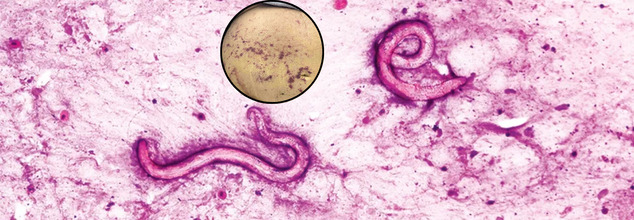- Health Conditions A-Z
- Health & Wellness
- Nutrition
- Fitness
- Health News
- Ayurveda
- Videos
- Medicine A-Z
- Parenting
- Web Stories
Subtle Warning Signs Of Serious Health Conditions That Only Your Partner Can Notice

Image Credits: Canva
When it comes to our health, we tend to rely on our own instincts to sense when something is wrong. There are, however, certain conditions develop in ways that make them difficult for an individual to notice, particularly when the symptoms occur while one is asleep or subtle behavioral changes. It is at such moments that your partner, who shares your space and knows one intimately, can be quite important in finding signs that may otherwise escape detection.
The caring partner is not only a buddy—they can become a valuable helpmate in having good health. By noticing a subtle warning and urging medical examination, partners have the ability to detect and manage potentially serious health issues before life-threatening situations set in.
If your partner mentions issues with your sleep habits, mood, or body changes, it's crucial to pay attention to what they are observing. Early detection can go a long way in treating conditions and avoiding complications later on.
One of the most neglected yet severe health problems that a partner is most likely to detect is sleep apnoea—a sleeping disorder that stops and starts breathing, tending to result in serious health dangers. But outside of sleep patterns, there are many other illnesses where a second set of ears and eyes can be life-saving.
What is Sleep Apnoea?
Sleep apnoea is an intermittent cessation of breathing during sleep. Obstructive sleep apnoea (OSA) is the most prevalent type and results from an obstruction of the airway that limits airflow, causing temporary stoppages in breathing. Although the individual with sleep apnoea is not aware of these interruptions, a sleeping partner will observe characteristic signs such as:
- Repeated loud snoring
- Gasps, chokes, or snorts
- Excessive awakenings during the night
- Abnormal restlessness while asleep
Daytime symptoms, including severe tiredness, headaches, poor concentration, and mood changes, can also suggest the existence of the condition. Sleep apnoea can cause high blood pressure, cardiovascular disease, stroke, and type 2 diabetes if left untreated.
If your partner notices these symptoms, obtaining medical guidance and having a sleep study can result in a successful diagnosis and treatment plan, which may include lifestyle modifications, CPAP (Continuous Positive Airway Pressure) therapy, or surgery in extreme cases.
Subtle Changes That May Signal Underlying Issues
Other than sleep disorders, a partner may also note gradual or sudden behavioral and appearance changes that may signal serious health issues. Examples of these are:
1. Sudden Mood Swings and Irritability
Mood changes, heightened irritability, or depression signs sometimes indicate underlying illnesses like thyroid diseases, diabetes, or even neurological disorders like Parkinson's or Alzheimer's. If your partner points out extreme mood changes in you, it would be advisable to discuss the same with a healthcare professional.
2. Skin Color or Texture Changes
Your spouse might be the first to spot slight changes in your skin, e.g., yellowing (indicative of liver disease), dark spots (which can signal insulin resistance or prediabetes), or abnormal moles (which could be early signs of skin cancer). Skin color change, chronic rashes, or spontaneous bruising should never be taken lightly and should be checked by a doctor.
3. Frequent Night Sweats
Night sweats are sometimes explained by stress or overheating, but regular night sweats might signal infections, endocrine imbalances, or even certain cancers such as lymphoma. If your partner points out that you're always waking up in sweat, a trip to the doctor is advised.
4. Abnormal Breathing or Heart Rate While Sleeping
If your partner observes pauses in your breathing beyond sleep apnoea or notices an irregular heartbeat when you’re at rest, this could indicate underlying cardiovascular issues. Atrial fibrillation (AFib) and other heart-related conditions often present with subtle symptoms that a sleeping or resting individual may not recognize but could be evident to a close observer.
5. Significant Weight Loss or Gain Without Explanation
Unexplained fluctuations in weight accompanied by no diet or exercise plan change can signal thyroid dysfunction, diabetes, or even gastrointestinal diseases such as Crohn's disease or celiac disease. Your partner should get medical help investigated if they witness inexplicable fluctuations in weight.
If your partner notices any of these symptoms, it's not good to brush off their worries. Most serious medical conditions are easiest to treat when they are diagnosed early. The following are what to do if a partner is concerned about your health:
Maintain a Symptom Journal: Document any alterations in sleep, behavior, appetite, or body symptoms.
Make an Appointment for a Medical Check-Up: Even when you are feeling well, a medical professional can conduct tests to eliminate any underlying causes.
Undergo Diagnostic Testing: If symptoms are indicating problems such as sleep apnoea, diabetes, or heart disease, your physician may advise you to undergo a sleep study, blood work, or heart monitoring.
Make Lifestyle Changes: Many of these conditions, including sleep apnoea and heart disease, can be alleviated by weight reduction, a healthy diet, and proper exercise.
How Abortion Policies Have Changed Across States Since Dobbs Ruling

Credits: Canva and Piktochart
In June 2022, the U.S. Supreme Court issued a landmark decision in Dobbs v. Jackson Women’s Health Organization, overturning the 1973 Roe v. Wade ruling that had established a constitutional right to abortion. With the Dobbs ruling, the authority to regulate abortion returned to individual states—setting off a wave of legislative action that continues to reshape access to abortion care across the country.
Three years later, the national abortion landscape is more fragmented than ever. Some states have implemented near-total bans, while others have enshrined protections into their constitutions. As legal battles unfold and ballot measures continue to appear, access to abortion has become heavily dependent on geography.
tates That Ban and States That Protect
As of mid-2025, abortion is nearly banned in 13 states, with limited exceptions such as life endangerment or cases of rape or incest.
In over 25 other states, gestational limits range from six to 26 weeks. These restrictions are particularly concentrated in the South and Midwest, where legislative action following the Dobbs decision was swift.
Conversely, several states have moved to protect or expand abortion rights.
Since 2022, voters in California, Michigan, Ohio, and Vermont have passed constitutional amendments guaranteeing the right to abortion.
In states like Kansas, Kentucky, and Montana, voters rejected ballot measures that would have added new abortion restrictions.
In Missouri—a state that implemented one of the country’s strictest abortion bans immediately after the Dobbs ruling—voters passed a measure in 2024 to enshrine abortion access in the state constitution.
However, that decision was followed by further legal disputes. The Missouri Supreme Court later blocked abortion access again, and lawmakers have approved another referendum for 2026 that could reverse the constitutional amendment.
Increased Travel and Rising Costs for Abortion Seekers
As access has narrowed in certain states, more people are traveling long distances to obtain abortion care. According to data from The Brigid Alliance, an organization that provides travel and logistical support to abortion-seekers, average travel distances have increased nearly 50% since the Dobbs ruling. Today, many patients are traveling more than 1,400 miles round trip to reach a provider.
The group also reports that average travel-related expenses have risen to more than $2,300 per patient—reflecting the rising cost of transportation, lodging, and time away from work. The majority of their clients seeking assistance now come from states like Texas, Florida, Georgia, and North Carolina, where laws have become increasingly restrictive.
Southern states, in particular, have emerged as areas where abortion access is most limited. For example, Florida implemented a six-week abortion ban after a proposed constitutional amendment to protect abortion access narrowly failed, receiving just under the 60% threshold required for passage. This has redirected patients to other states with more permissive laws, such as Virginia.
Ballot Measures Shape State Policies
Since the Dobbs ruling, many abortion-related measures have appeared on state ballots—either to protect or restrict access. In 2024 alone, voters in Arizona, Colorado, Maryland, Missouri, Montana, Nevada, and New York took up initiatives involving abortion rights. Most successful measures focused on preserving access until fetal viability, generally considered to occur around 24 weeks of pregnancy.
Not all efforts to expand abortion rights have succeeded. In Nebraska, voters faced competing ballot measures—one aiming to restrict abortion after the first trimester (which passed) and another to guarantee abortion access up to fetal viability (which failed). South Dakota also rejected a measure to protect abortion rights.
Reflecting
Three years after Dobbs, the U.S. remains sharply divided on abortion access, with legal and political fights continuing to play out across state lines. As more ballot measures are introduced and court rulings evolve, the future of abortion rights in America remains uncertain—shaped less by federal law than by the individual choices of state governments and their voters.
Is Collagen Worsening Type 2 Diabetes?

Credits: Canva
A new study published in the Journal of the American Chemical Society offers critical insight into the biological mechanisms underlying type 2 diabetes. Researchers from the Indian Institute of Technology Bombay (IIT Bombay), in collaboration with IIT Kanpur and the Chittaranjan National Cancer Institute (CNCI), Kolkata, have identified a key trigger that accelerates the progression of this widespread disease: the structural protein collagen I.
A Rising Global Health Crisis
Type 2 diabetes currently affects over 500 million people worldwide, and numbers are expected to rise sharply in the coming decades. The disease is primarily driven by a combination of genetics, lifestyle factors, and complex cellular mechanisms. At its core lies the dysfunction of pancreatic β-cells, the insulin-producing cells responsible for regulating blood sugar levels.
As diabetes develops, β-cells either fail to produce enough insulin or the body’s cells become resistant to it. A lesser-known yet crucial hormone, amylin, is also secreted by these β-cells and plays a vital role in managing blood sugar after meals. However, in diabetic conditions, excessive amylin production leads to misfolding and toxic clumping, which damages β-cells and accelerates disease progression.
Collagen I Accelerates Amylin Clumping
In the latest study, the research team pinpointed fibrillar collagen I, a common component of the extracellular matrix, as a key factor driving the toxic aggregation of amylin. Found abundantly in connective tissues like skin and bones, collagen I is also present in the pancreatic environment—particularly in diabetic tissues where it is elevated.
“Every tissue is composed of cells and an extracellular matrix that provides structural support. In diabetic pancreatic tissue, this matrix, especially collagen I, becomes more prominent,” explained Prof. Shamik Sen, the study’s lead investigator from the Department of Biosciences and Bioengineering at IIT Bombay.
The researchers discovered that collagen I acts like a scaffold or platform, accelerating the misfolding and aggregation of amylin, which in turn damages β-cells. This discovery adds a new layer to understanding why the disease worsens over time, even with treatments targeting cellular pathways.
Biophysical Evidence Supports Findings
To investigate how collagen I interacts with amylin, the team used a suite of advanced biophysical tools. These included surface plasmon resonance to measure binding strength, atomic force microscopy to study molecular adhesion, thioflavin T fluorescence to track aggregation speed, and NMR spectroscopy to identify interacting regions of the molecules.
“Amylin almost coats the collagen fibres, forming stable, toxic aggregates that cells struggle to clear,” said Prof. Sen. The behavior of amylin on collagen fibres resembled trains moving on tracks—quickly and with destructive momentum.
Computer simulations by Prof. Prasenjit Bhaumik’s group at IIT Bombay confirmed that fibrillar collagen I accelerates the toxic aggregation process, offering further validation of the molecular interaction.
Biological Evidence from Mouse and Human Tissues
The team extended their study to biological samples from diabetic mice and humans. With the help of Prof. Hamim Zafar and Prof. Sai Prasad Pydi from IIT Kanpur, and Dr. Sankhadeep Dutta from CNCI, they analyzed single-cell data and tissue architecture.
The findings were striking: as diabetes progressed, both collagen and amylin levels rose, accompanied by damage to pancreatic islets—clusters of cells that house insulin-producing β-cells.
Testing the Combined Effect on Cells
To test the functional impact, the researchers grew lab-engineered β-cells on collagen gels containing amylin. These cells showed increased oxidative stress, reduced insulin production, and higher rates of cell death, compared to controls grown without collagen or amylin.
This suggests that the extracellular environment, particularly collagen I, plays a central role in worsening β-cell dysfunction in diabetes.
The findings could explain why many diabetes treatments fall short—they overlook the external microenvironment contributing to disease progression. “Unless we disrupt the interaction between amylin and collagen, we may not be able to eliminate the toxic pancreatic environment,” said Prof. Sen.
Looking ahead, the team is working on cryo-electron microscopy (cryo-EM) models to visualize how amylin and collagen interact at the molecular level. They are also exploring 3D tissue engineering strategies to restore pancreatic function by replicating healthy extracellular conditions.
Man Battles Deadly Parasites 'Crawling In His Body' After Kidney Transplant—A Rare Risk Doctors Warn About

Credits: The New England Journal of Medicine ©2025
A horror that bothers most transplant patients came true in the most weirdest way possible, two U.S. kidney transplant recipients were found to be infected with parasitic worms from a single deceased donor. The shocking revelation was documented in a case report published June 18 in the New England Journal of Medicine, shedding light on rare but severe donor-derived infections that may be slipping through existing screening protocols.
The source of the infections was traced back to a single deceased donor who had lived in the Caribbean, a region where some parasitic infections are more common. The donor’s kidneys were transplanted into two men at separate hospitals—Massachusetts General Hospital (MassGen) and Albany Medical Center—setting off a medical mystery that would take weeks to unravel.
The first recipient, a 61-year-old man, underwent surgery at MassGen. Ten weeks after the transplant, he was readmitted to the hospital with a cascade of alarming symptoms: nausea, vomiting, excessive thirst, abdominal and back pain, and fever. His condition deteriorated rapidly, with fluid building up in his lungs, a dramatic drop in oxygen levels, and eventually, respiratory failure and shock. Doctors in the intensive care unit noted a distinctive purple rash—like a constellation of bruises—spreading across his abdomen.
Dr. Camille Kotton, an expert in infectious diseases and transplants, led the investigation. She recalled previous cases of organ recipients being infected by Strongyloides stercoralis, a small roundworm commonly found in tropical and subtropical climates. Reaching out to New England Donor Services, the team discovered that the kidney donor—who had resided in the Caribbean—had indeed carried antibodies for Strongyloides, confirming prior exposure.
Testing of the recipient’s blood confirmed he had no preexisting antibodies for the parasite before the transplant but had developed them afterward. Further diagnostics revealed the worms had spread systemically, affecting his lungs, abdomen, and skin. The parasite had essentially colonized his entire body, exploiting his weakened immune defenses.
Further testing showed the patient had developed antibodies to the parasite post-transplant, and samples from his body revealed that the worms had spread to his abdomen, lungs, and skin.
How Rare Are Parasitic Infections in Transplants?
Infections from transplanted organs are exceedingly rare. Over more than a decade, only 14 out of every 10,000 organ transplants in the U.S. have resulted in donor-derived infections, according to a major review. Of these, parasitic infections—especially those caused by Strongyloides—account for a significant portion, but the overall numbers remain very low.
Historically, fewer than one in four U.S. organ procurement organizations regularly screened for Strongyloides. However, as awareness of these risks has grown, the Organ Procurement and Transplantation Network in 2023 called for universal testing for this parasite in all donors.
The discovery at MassGen prompted a nationwide alert to other centers that had received organs from the same donor. At Albany Medical Center, a 66-year-old man who had received the other kidney was experiencing fatigue, low white blood cell counts, and worsening kidney function. Armed with the new information, his doctors quickly diagnosed and treated the parasitic infection, preventing the severe complications seen in the first patient.
Why it is Important to Strengthen Safety Protocols?
This unsettling incident underscores the importance of rigorous donor screening, especially when donors have lived in regions where parasitic infections are more prevalent. The case has already prompted policy shifts and reinforced the need for continual vigilance in transplant medicine.
"Although donor-derived infections are uncommon, when they do occur, they can be catastrophic. We must use every tool available to prevent such outcomes," said Dr. Kotton.
These cases have prompted renewed calls for rigorous screening of organ donors, especially those from regions where certain parasites are endemic. While U.S. doctors already avoid using organs from donors with known active infections like tuberculosis, not all infectious agents are routinely tested for, and some, like Strongyloides, can remain dormant and undetectable for years.
Universal screening for Strongyloides is now being implemented, but experts caution that vigilance must remain high. Immunosuppressed patients—such as organ transplant recipients—are particularly vulnerable to rare infections, and symptoms can be easily mistaken for other complications like transplant rejection or drug reactions.
For patients awaiting transplants, the story may raise unsettling questions, but experts stress that the benefits of organ transplantation far outweigh the risks. The U.S. transplant system has an excellent safety record, and cases like these, while alarming, are extremely rare and now more preventable than ever.
Patients can play a role by staying informed, asking about donor screening protocols, and adhering closely to post-transplant care guidelines. As science and medicine evolve, so too does the capability to ensure safer, more effective transplants across the board.
© 2024 Bennett, Coleman & Company Limited

